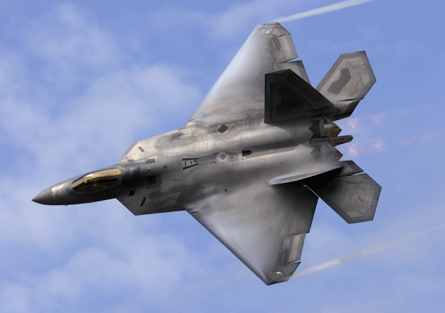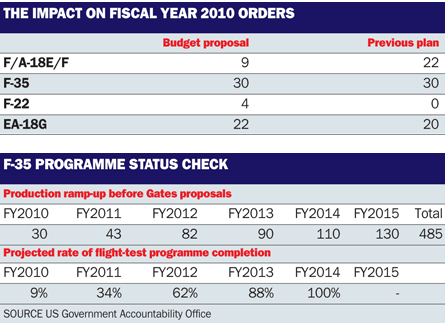US Secretary of Defense Robert Gates has proposed the most sweeping changes to the nation's airpower capability since the end of the Cold War. His plan could wipe out hundreds of fighters from the inventory and dramatically raise the profile of unmanned air systems.
The most notable change would require Lockheed Martin to halt F-22A production after 189 aircraft, including three crashed jets, to cap the US Air Force fleet at 186.
Gates has also proposed to park the 250 oldest Boeing F-15s and Lockheed F-16s, which may seem a bitter twist for USAF planners. USAF officials had floated a proposal late last year to retire as many as 137 F-15s and 177 F-16s. If their goal was to raise funds to extend F-22A production, the budgetary gamble appears to have backfired.
The US Navy's airpower capability would also not be spared. Although the USN has argued that its carrier battle groups face a "fighter gap" starting after 2017, Gates has proposed buying 13 fewer Boeing F/A-18E/Fs than originally planned in fiscal year 2010.
 |
|---|
© Lockheed MartinLockheed Martin F-22 |
Even plans to accelerate Lockheed F-35 production - the lone bright spot in the Gates plan for traditional airpower - would not offset the proposed cuts for other programmes. Over the next six years, the US Department of Defense would acquire 28 more F-35s, but the overall number in the programme would remain the same at 2,443.
Gates's budget plans did not single out airpower alone. The USN would lose its most ambitious shipbuilding programme - the DDG-1000 destroyer. The ground vehicles that form the heart of the US Army's Future Combat Systems (FCS) would also be eliminated.
However, the tactical airpower programmes were alone among the budget cuts for their lack of offsetting increases. While the DDG-1000 would be replaced by reactivating DDG-51 destroyers, and the FCS vehicles would initially be backfilled with mine-resistant ambush vehicles, there are no replacements for the losses of fighters from the inventory.
In Gates's view, the Pentagon is over-invested in tactical combat aircraft optimised for conventional conflict against a peer-competitor, a belief he has repeated in speeches for more than a year.
"Every defence dollar spent to overinsure against a remote or diminishing risk or, in effect, to run up the score in capability where the United States is already dominant is a dollar not available to take care of our people, reset the force, win the wars we are in, and improve capabilities in areas where we are underinvested and potentially vulnerable," Gates says.
 |
|---|
Pentagon leaders instead want to rebalance spending on weapon systems that can be applied across a broad spectrum of conventional and irregular threats.
"I believe these are the right choices," says Gen James Cartwright, vice-chairman of the Joint Chiefs of Staff. "These are going to put us in a position of advantage as we move into the future."
Gates has forwarded his recommendations in a $534 billion defence spending proposal for FY2010 to the White House for approval. The final budget request is then sent to the US Congress. Some lawmakers, who question the relative austerity of the defence bill amid massive economic stimulus proposals and two armed conflicts, are preparing for a major battle.
But most details about Gates's full proposal to the White House are unknown. Only a handful of what he estimates as 50 to 60 programme decisions have been released, but even those few contained sparse details.
A major source of puzzlement is focused on Gates's decisions about the F-35 programme. He is apparently maintaining the current plan to raise low-rate initial production from 14 aircraft this year to 30 next year. But Gates has proposed to buy 513 F-35s over the six years, or 28 more than is now planned.
At the same time, Gates says the DoD will buy F-35s at a slower rate to avoid overwhelming Lockheed's production system. Although this would appear to contradict the acceleration strategy, it is possible that the production ramp would be slowed from FY2011 to FY2013, and then back-loaded from FY2014 to FY2015.
The F-35's budget numbers for FY2010 also seem puzzling. Gates has proposed spending $11.2 billion in FY2010, or at least $2.3 billion more than the current plan. It is not clear what all the extra funding buys, since the number of low-rate initial production aircraft purchased in FY2010 remains unchanged. Instead, the Pentagon may add more flight-test aircraft and accelerate flight testing activity.
Source: Flight International























